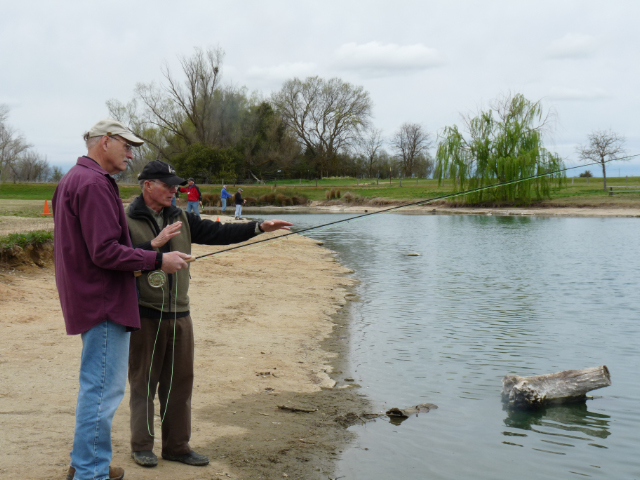I took my Tracker Boat out on the Sacramento Delta to dust off the cob webs and fish into the evening. Scott B and I shot this using our new toys/tools, the Crane2 with a Canon 7d Mark II and a Mavic Pro.
Fly Fishing
Gold Fever
After 4 years of fishing The Middle Fork American River, we finally connected the dots to show this trip in the best possible way. After a day of fishing, Mikey Wier and I started talking about how to produce this film in a most interesting way.
When the dates lined up and we could get the crew together, we made the trip happen. With Burl Productions completing the post production, we have an epic film on our hands. “Gold Fever” is currently entered into The International Fly Fishing Film Festival, and will be on tour for the rest of the spring, 2016. With El Nino in full effect it looks like we may have a good water season this year. To book a fishing trip down the Middle Fork American River, visit www.riseuprivertrips.com.
Fly Fishing: Paradise Lodge – Mexico
Paradise lodge is located on the East coast of the Yucatan Peninsula on a thin strip of beach directly between Espiritu Santo Bay and Chetumal Bay. After flying into Mexico, it’s a five hour drive south from Cancun in a cool, air conditioned van. Anticipation builds, and we look forward to spending long days fishing the two bays and inland brackish lakes.
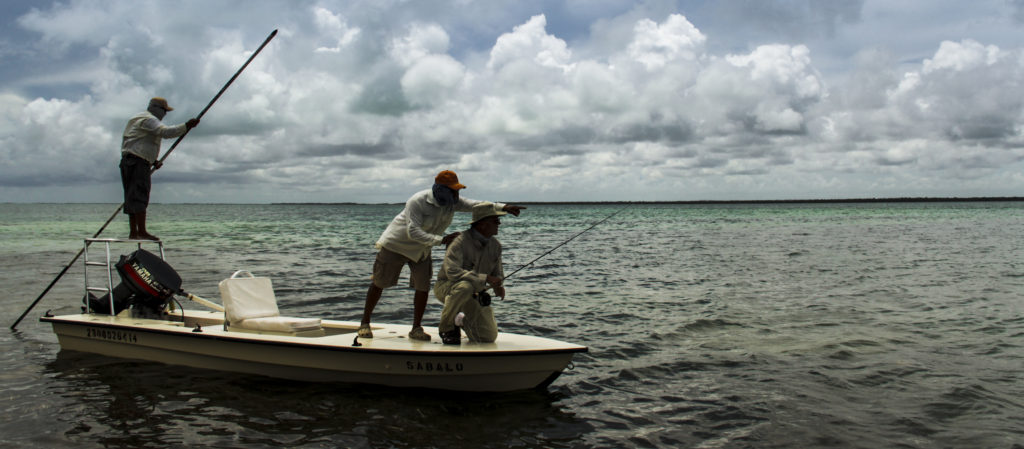
Paradise Lodge is situated right on the beach. They were hit by hurricane a while back so the local area is still recovering, and the vegetation is very sparse. Even though they are rebuilding, the area’s remoteness adds to the allure of this special place.
On my first trip to the lodge, Eric the lodge manager, asked us what we wanted to fish for. In unison, my dad, John and I both said, “Permit!” We came for permit due to their elusiveness and ability to put up monster fights that feel like you have a sailboat on the end of your line.
John and I have now been to Paradise Lodge twice, and we’re on our way back for a third in the fall of 2015. All the guides are great, but so far, Arturo is our favorite. He was with us when John caught his biggest permit, and we’re hoping to fish with him again.
 When fishing the lakes, the lodge tows small boats with outboard motors to location. However, when fishing Espiritu Santo Bay and Chetumal Bay, the lodge has local style panga boats stored at the water. These boats have a fiberglass casting deck built up on the bow, and guides have a platform built up over the motor for poling quietly through the flats and into the mangroves.
When fishing the lakes, the lodge tows small boats with outboard motors to location. However, when fishing Espiritu Santo Bay and Chetumal Bay, the lodge has local style panga boats stored at the water. These boats have a fiberglass casting deck built up on the bow, and guides have a platform built up over the motor for poling quietly through the flats and into the mangroves.
We mostly use 8 or 10 wt. rods with PT crystal clear lines. Sometimes we’ll use an intermediate sinking line, but mainly we use floating lines with long 40-60 pound test leaders. They’re equipped with a breakaway so we’re less likely to lose our fly line in case the fish breaks off.
Two primary flies we use are the black gurgler and squimp. The black gurgler is fished on the surface when we’re going for tarpon, and the squimp is fished below surface when targeting permit and bonefish.
It takes about an hour and a half to drive 30 miles to Espiritu Santo Bay from the lodge, so to avoid so much time riding in vehicles; we usually only spend a couple of days fishing there.
On the last trip there, we were lucky enough to spot a pod of Permit feeding in a long shallow flat. After John took numerous shots, he handed me the rod, and on my second cast, I hooked into this big guy and was lucky enough to land this fish-of-a-lifetime. As soon as this fish was released, John wasted no time getting back up on the casting platform. He hooked right into a nice permit as well. It was not as big as mine, but he made up for it on the last day of that trip by catching the best fish of his life.


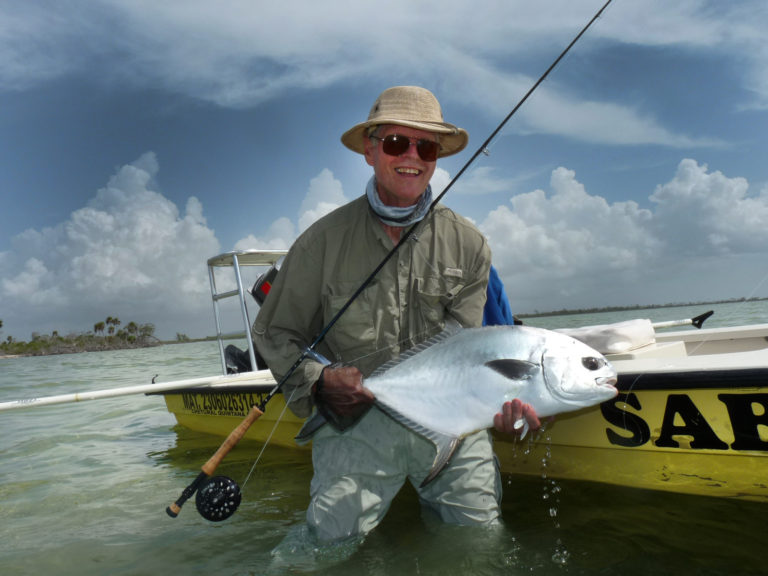
On the other days, we’ll fish one of the inland lagoons in search of tarpon. Due to the confined nature of the mangrove lagoons, you are actually spot fishing. So anglers must hunt for the fish before ever making a cast. But once you find a pod of rolling Tarpon, the fun begins. Typically, we’ll land a few tarpon and jump maybe a dozen more. Above-right is a photo of John with a Bugle Boy, a native fish to the area, that somewhat resembles a bass.
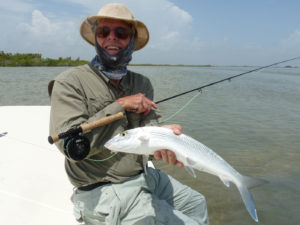 Another unique aspect of this trip is the inland brackish lagoons located near the lodge. Spotted from the air, these waters have been opened up by the local guides bushwhacking in with their machetes. I understand that they are connected to the ocean via underground tubes, and this is supposedly how the fish arrived. Once in the lagoons, we fish for tarpon and snook.
Another unique aspect of this trip is the inland brackish lagoons located near the lodge. Spotted from the air, these waters have been opened up by the local guides bushwhacking in with their machetes. I understand that they are connected to the ocean via underground tubes, and this is supposedly how the fish arrived. Once in the lagoons, we fish for tarpon and snook.
As the tide comes in, the tarpon move into the mangroves to feed, and we are able to see them rolling and hear them crushing bugs. However, when the tide moves out, the tarpon must move out as well. So our tactics change to ambushing them as they head to open waters.
Once we are done fishing for the tarpon, we can then move out of the mangroves and back onto the flats to sight-fish for bonefish, meaning we don’t cast until we actually see a fish. The guide will silently maneuver the boat into position and the angler gets one chance to present the fly. If the presentation is good, it’s game on!
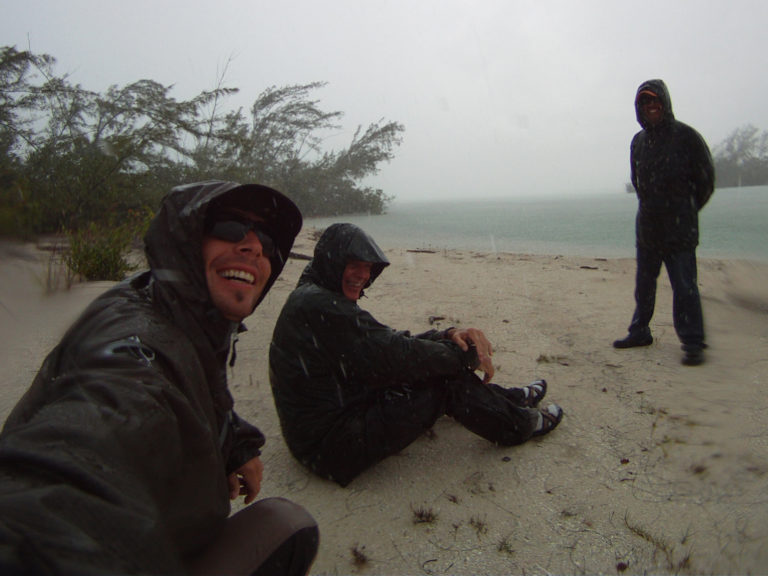
Occasionally, storms will roll over us while we are fishing. This usually makes a great opportunity to take a break and eat some lunch. However, when you’re overrun by a thunder storm, it’s a different story. Here’s a moment when the lightning was so close, we had to get off the water and wait for the storm to pass. We still ate lunch.

John landed this Permit in the last hour of one of our trips. What an amazing fish!
 I have fished all over the world and I can easily say that Paradise Lodge delivers a world class fishing experience. When you hook into a 40 pound permit, you better be ready for the fight of your life as these fish can sometimes take more than an hour to land! On my last trip to Paradise Lodge, I broke off the biggest permit I’ve ever hooked. On my next trip I have one goal in mind… To catch the biggest permit of my life!
I have fished all over the world and I can easily say that Paradise Lodge delivers a world class fishing experience. When you hook into a 40 pound permit, you better be ready for the fight of your life as these fish can sometimes take more than an hour to land! On my last trip to Paradise Lodge, I broke off the biggest permit I’ve ever hooked. On my next trip I have one goal in mind… To catch the biggest permit of my life!
Belize River Lodge
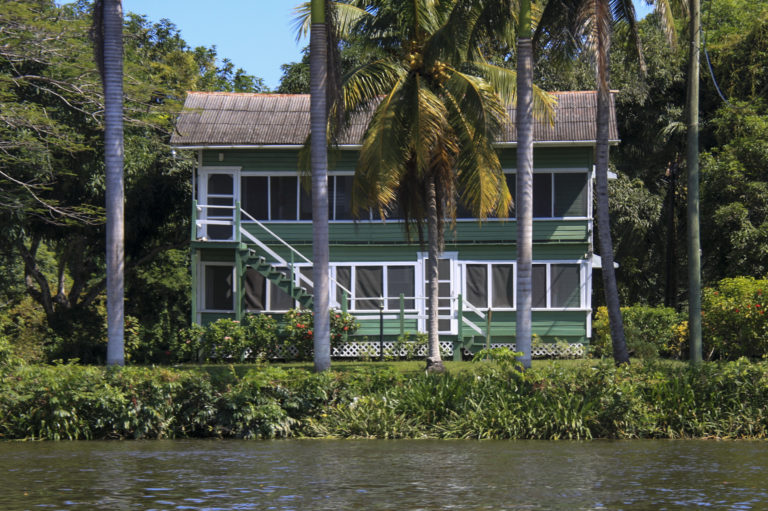 In 2009, I went to Belize River Lodge with my dad, John. This was my second salt water fly fishing experience following a trip to San Felipe, and I was looking forward to gaining more experience fishing for tarpon, permit, bonefish, snook, and more.
In 2009, I went to Belize River Lodge with my dad, John. This was my second salt water fly fishing experience following a trip to San Felipe, and I was looking forward to gaining more experience fishing for tarpon, permit, bonefish, snook, and more.
To get to the Belize River Lodge, we flew into Belize City and drove literally 2 miles from the airport into a dodgy neighborhood where the lodge boat was waiting to pick us up. From the dock, we crossed the river to get to the lodge. Even though the lodge is just outside Belize City, there is no road access.
There’s a lot of wildlife in the area and it was pretty cool to see an alligator lying on a nearby dock as we first arrived. There are birds everywhere as well. I have no idea what these birds are called, but my dad is pretty into them, so I usually shoot pictures of them as we pass.


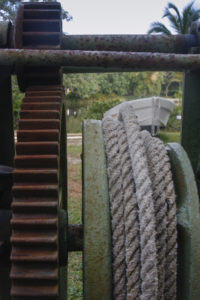

The old lodge is filled with history and adorned with beautiful native woodwork.
The fishing was good; however, we were not there in perhaps the best season, and there is a fair amount of pressure being so close to Belize City. We didn’t really see any permit and most of the tarpon were smaller in size. We did catch some great barracuda and bonefish though.
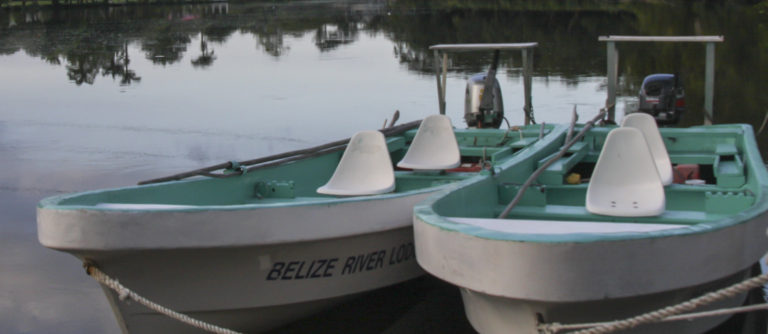
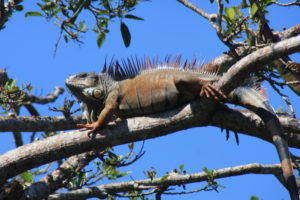 They use panga boats with casting platforms on the bow and poling platforms above the engine for the guide. Each day we fished, we would take the quick 15 minute ride downriver to Belize City Bay, passing million dollar homes along the way. At one of the homes, a massive iguana named “King Tut” perches on the top branch of a tree while looking over his harem.
They use panga boats with casting platforms on the bow and poling platforms above the engine for the guide. Each day we fished, we would take the quick 15 minute ride downriver to Belize City Bay, passing million dollar homes along the way. At one of the homes, a massive iguana named “King Tut” perches on the top branch of a tree while looking over his harem.
 Once we get to the river mouth, we search out the mangrove islands for our fishing grounds. While these mangroves provide habitat, they can prove to be challenging while fishing. One of my first bonefish that I hooked took two left turns around the trees wrapping my line the entire way. John, and our guide Pedro, thought this was funny. So, in no rush to help me free my line, they laughed at me while maneuvering the boat slowly to follow the line around. Once I freed the line, I almost fell out of the boat as I was trying to land the fish. Luckily, John grabbed me by my belt loop and kept me in the boat. This was the most memorial fish of the trip.
Once we get to the river mouth, we search out the mangrove islands for our fishing grounds. While these mangroves provide habitat, they can prove to be challenging while fishing. One of my first bonefish that I hooked took two left turns around the trees wrapping my line the entire way. John, and our guide Pedro, thought this was funny. So, in no rush to help me free my line, they laughed at me while maneuvering the boat slowly to follow the line around. Once I freed the line, I almost fell out of the boat as I was trying to land the fish. Luckily, John grabbed me by my belt loop and kept me in the boat. This was the most memorial fish of the trip.
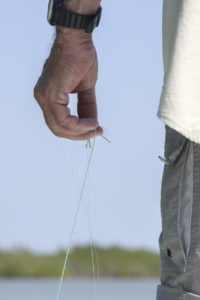

Further south, there is another river mouth with more flats where we were able to get out of boat and do some wade-fishing. On our way there, we passed these cobia fish farms destined for the Japan fish market. On our way back, we scan the coast looking for downed trees, then fish them for small tarpon and jack.
National Geographic article on cobia fish farms
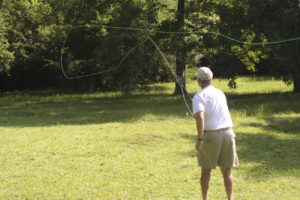 Casting is crucial when fishing for snook as they hold way back under the trees. So, after the first day of fishing, the guides set up a practice range for us with a trash can placed underneath a picnic table. The idea was for us to shoot the line into the can without hitting the table. This requires super tight loops.
Casting is crucial when fishing for snook as they hold way back under the trees. So, after the first day of fishing, the guides set up a practice range for us with a trash can placed underneath a picnic table. The idea was for us to shoot the line into the can without hitting the table. This requires super tight loops.
We used 8-9 wt. rods that were great for casting all day and performed well with the bigger fish. John put this set-up to use while catching the best fish of the trip. It was caught on our way home on the last day, at the last dock, and last island that we were planning to fish. As usual, John put down a perfect cast, presenting his chartrouse clouser, and slayed this tarpon. On the way back to the lodge that evening, we enjoyed another fine sunset, making for a great finish to the trip.
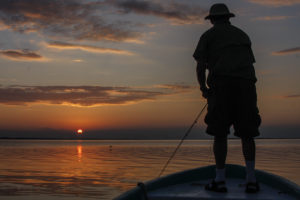

Striped Bass Fishing with Bryce Tedford
Robby and John Hogg went out with Captain Bryce Tedford on the Sacramento Delta. It’s October, 2015 and the striped Bass fishing is hot. This day, we each put so many fish to the boat that we’ve lost count. We even had a 20 pounder strike. However, at the end of the day, John pulled off a last minute top-water grab and landed a nice Striped Bass just as the sun set.

Floating The Middle Fork American
Here is a quick edit from a recent trip on the Middle Fork of the American River. We use double and triple articulated streamers and hunt for large brown trout.
Gold in Them Thar Hills
It did not take much for my good friend Christie Dobson to convince me that I should take her fishing. We have made two attempts to run the upper section of the Middle Fork of the American River without success, and we thought the third time was going the be the charm. On our first trip we set shuttle and made it almost all the way to put-in. Upon approaching the Tunnel Chute over-look, we noticed many whitewater rafting vans stopped. It turns out something happened at the dam and the scheduled release was cancelled for the day. So, we had to divert back to the lower section which you can float at 200cfs. On our second attempt, we made it to the river. Christie had a good day but lost a big rainbow towards the end of the day. She hooked it at the beginning of a long class II rapid. She managed to fight him all the way through the rapid, then I blew it and caught the wrong eddy. That one got away. Third times a charm, as always.

Here, Christie shows us here prize.

After this success I turned my attention to teaching Christie how to manage the oars so I could get some Rod time. It took some time but on the same fly, I was able to stick another nice Buck.

We were fishing a 200 grain full sink line with two feet of 0x. I tie a fly I call the Sex Pig. Its a cross between Kelly Gallops ‘Sex Dungeon” and the “Ditch Pig”. Strip as fast as you can….
2014 Middle Fork American River Fishing Season Begins
With the spring water levels already starting to level out, the boys and I wanted to get into the Middle Fork of the American as soon as we could this year. So, we did our first trip at the end of April, knowing that there was not any guaranteed water release from the upstream dam. As Murphy’s Law dictates, our luck did not pan out. During the night the water dropped from 600cfs to 200cfs, leaving us stranded on the river and unable to reach our designated point. Luckily we were able to contact State Parks by cell phone and take out at an earlier access point, normally behind a locked gate.

Oxbow Powerhouse started giving us guaranteed flows at the end of may, and during the summer months, we have water 7 days a week for 5 hours a day. With three trips on the books already this year we have been seeing some of the big browns moving in the river, and, we have been luckly enough to stick a few as well.

Above Terry Thomas from Kiene’s Fly Shop shows off a beautiful buck he caught while pulling a black streamer.
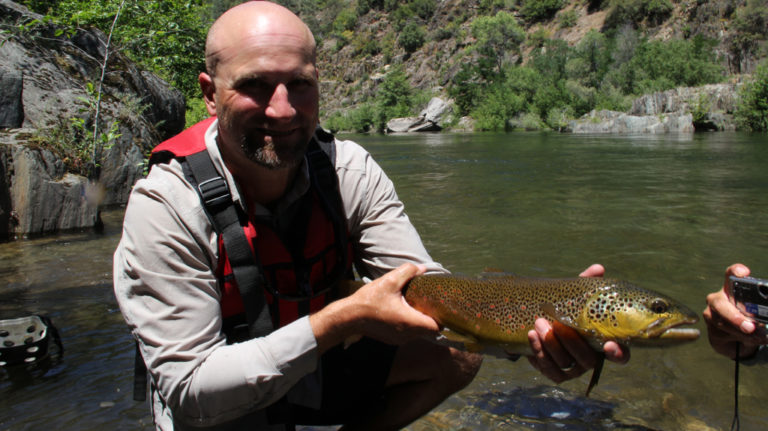
Here Derrik, another local guide, shows us some pretty red spots.

Here, Grady Garlough, our head guide, demonstrates how to properly get photographed with a big Brown.

We are up and running for the 2014 summer season. For Booking information visit www.riseuprivertrips.com
American Creek, Katmai National Park Alaska
From Sacramento to put-in required five flights over a two day period. On the second to last leg of the flight, we stopped at Rainbow River Lodge to load the plane for the final push to put-in.
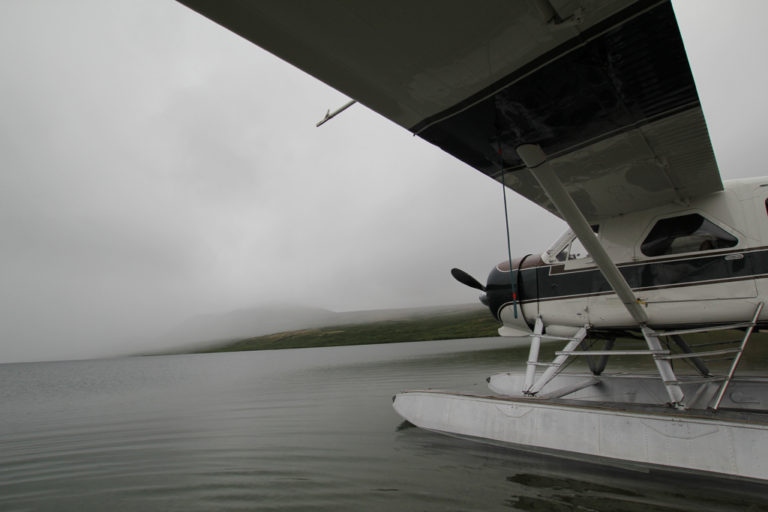
After waiting for the cloud ceiling to lift, we were on our way and set to arrive mid day.
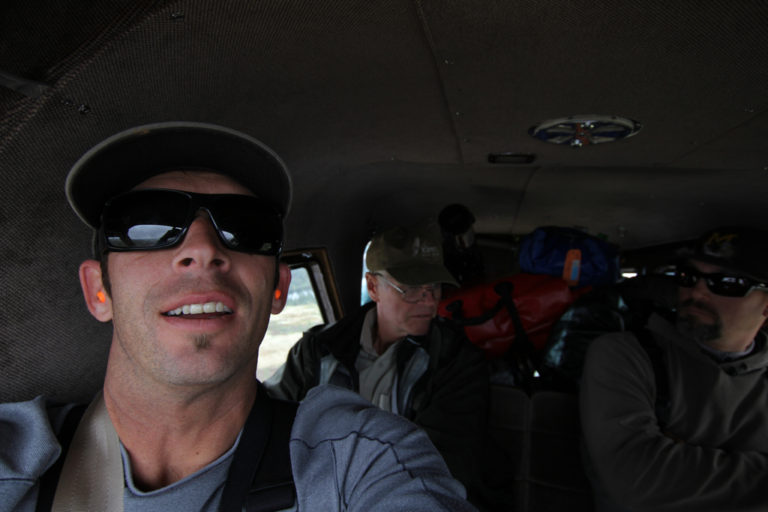
The pontoons of the small plane settled on the water without even a bump, and we motored toward the beach.
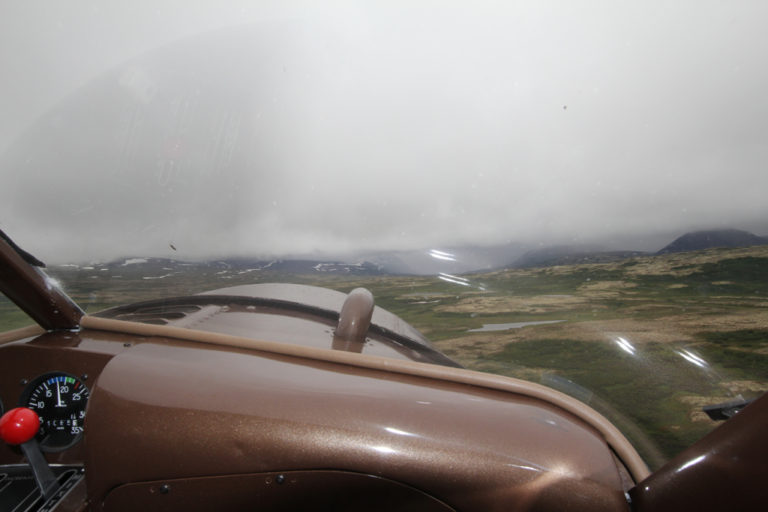
In a few minutes we are off-loading all of the gear that will support us for a 6 day float down American Creek – which is actually a river with a flow of about 1200 cfs. Our put in is Hammersley Lake, about 60 miles south of the southern shore of Lake Illiawma.

Our guide , Jon Streeter quickly inflates the 14 foot raft, attaches the oar frame, and begin loading the gear –tents, stove, chairs, cots, spare oar, water filter system, bear box with all of our food….. our gear goes on as well, fly rods, and equipment, clothing for all types of weather, toilet kit, cameras, and a couple of books – everything in waterproof bags.
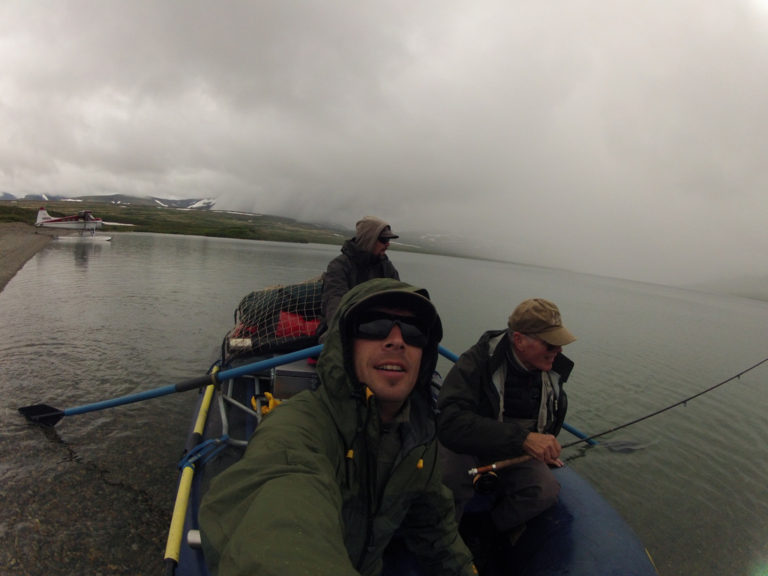
For the next 6 days, we will live in our boots and waders, and layered clothing that ranges from only a T-shirt on a day when the temperature exceeds 80 degrees, to seven layers of clothes – (everything I had), when we encounter cold rain, heavy winds, and temps in the low 40’s.
Now loaded with our gear, plus three guys, Jon, my son Robby, and myself we slowly enter the creek. Over the next six days we will cover about 45 miles to reach our take out at Lake Colvill.
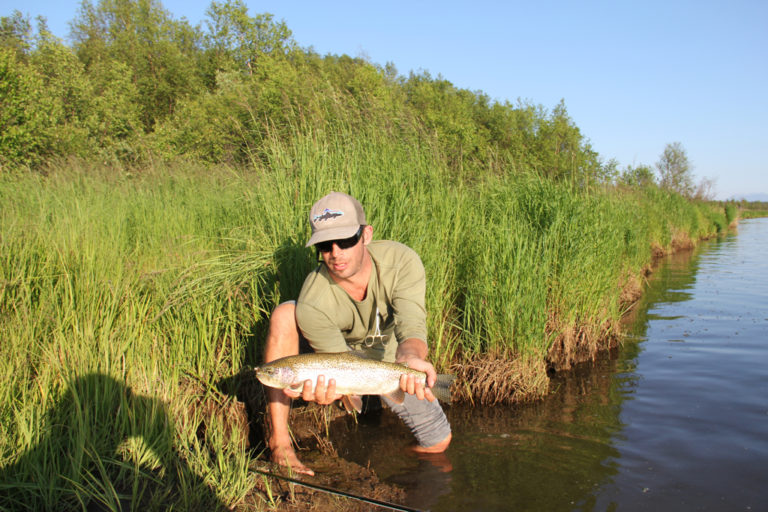
The first fish belongs to Robby, a 22 inch rainbow that falls for a size 14 Adams. The weather is drizzly and very wet, there is no wind; this section of the river is very wide, wadeable all the way across, with lots of small riffles and long glassy runs. We are using 0X tippet – they are not leader shy.
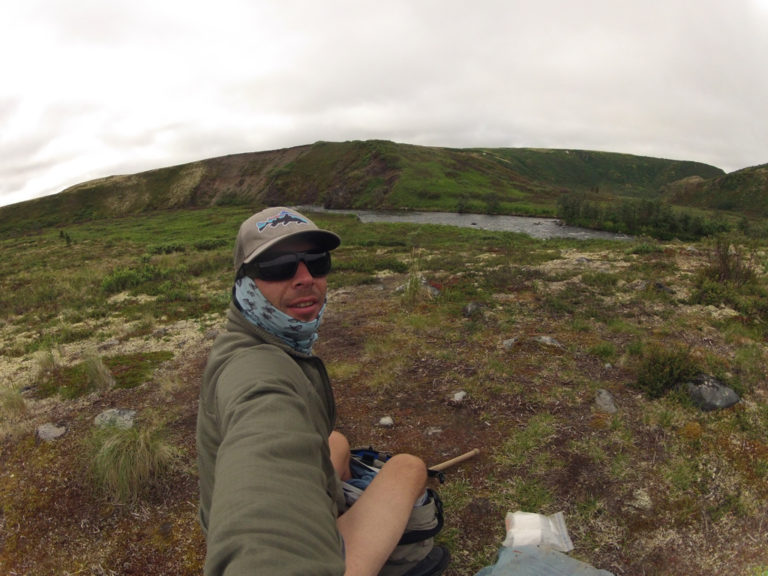
The afternoon passes quickly – we land numerous rainbows up to 23 inches. But now we have to get down the river a couple of miles and set up camp. A small damp, gravel bar will be our home for the night. It looks singularly uninviting until our cook tent goes up, some chairs get set up, and we start snacking on some cheese, salami, and crackers. At 11 o’clock in the evening, the sun still has not set, we go to bed with our hats shading the still bright light.

On our second day we remain in tundra terrain, and camp about 100 yards from a long deep run, with a large back eddy on the far side. Nymphing the run immediately produces a nice char, and then another and another, and another. Robby and Jon wade across and search for an angle to present a dry fly in the eddy, and ‘boom!’, its fish on with a big rainbow.

The char hug the bottom and only seldom will jump after being hooked, but the quantity of them in this run is astounding.

Now we are moving down into heavily forested terrain. We see our first grizzly with two cubs about a mile away. She is maneuvering down a steep slide area several hundred feet above the river when she loses her footing and rolls head over heels for 100 feet or so.

Well, it just shows that its not just humans that take risks in the heights, and it turns out she appears to be uninjured. At camp that night we are introduced to Alaska’s national bird, the mosquito.

I have a spray bottle of 100% Deet and it is my constant companion for the next few days. Our guide Jon who is exposed for the entire season is reluctant to use Deet on a daily basis, so he wears a head net.
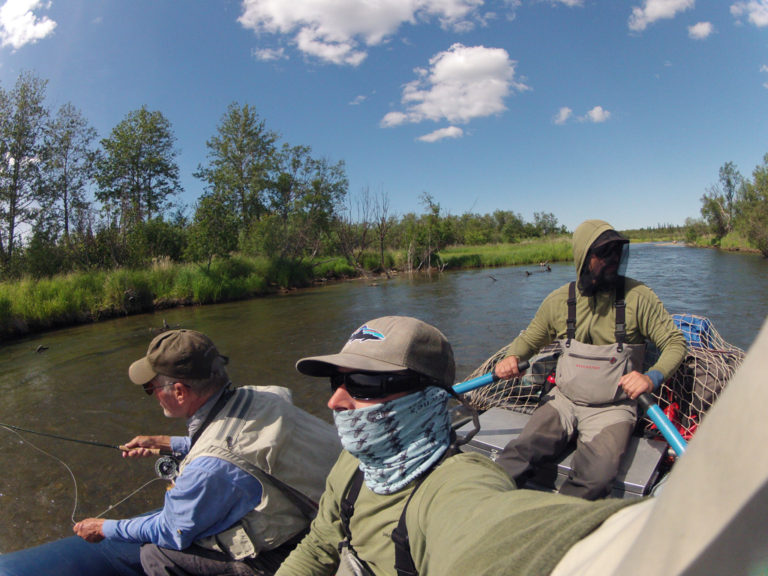
As we lose altitude, more grizzlies appear like ghosts moving in and out of the dense brush. They want nothing to do with us. In fact when they are close they refuse to make eye contact.

They just turn and leave, or keep moving on. It is clear that neither party wants anything to do with the other.

The gradient of the river is steeper now, about 450 feet per mile. Lots of pocket water; the river braids into multiple small channels. Several times we are forced to exit the raft and clear away logs and brush to keep moving. At one point the river comes together and there is a huge rapid – class 4, which Jon expertly negotiates.

On our 4th day we have dropped over 1000 feet in elevation and we start to see a few fleeting red forms in the water – sockeyes! This is what is drawing the bears, but as yet, the sockeye are still too few in number and too fresh and fast for the bears to catch them.

The weather changes to unbelievably hot 85 degrees or so. Moose flies, which are gigantic versions of horse flies buzz around us constantly. The fish shut down – we don’t get a hit for hours-, so we entertain ourselves killing moose flies with our hat brims.

Jon offers us his own mouse pattern – made something like a gurgler with gray foam and of-course legs and a tail. This pattern, and some big stimulators produce well.

It is hard work, we have to wade down the middle of the river and work the banks and pocket water… but in my view, there is nothing more satisfying in fly fishing that drawing strike with such a presentation.

In one small run I hook a sockeye. It is nine pounds of saltwater muscle. In a few seconds all my line and most of my backing is off the reel. The fish is 150 yards down the river. John Streeter is trying to get a hold of my fly line (before I lose the whole thing), and the fish is now thrashing just a few feet from Robby, who now tails it.

The fish turns out to be dinner – salmon fritters – just a couple of hours later.
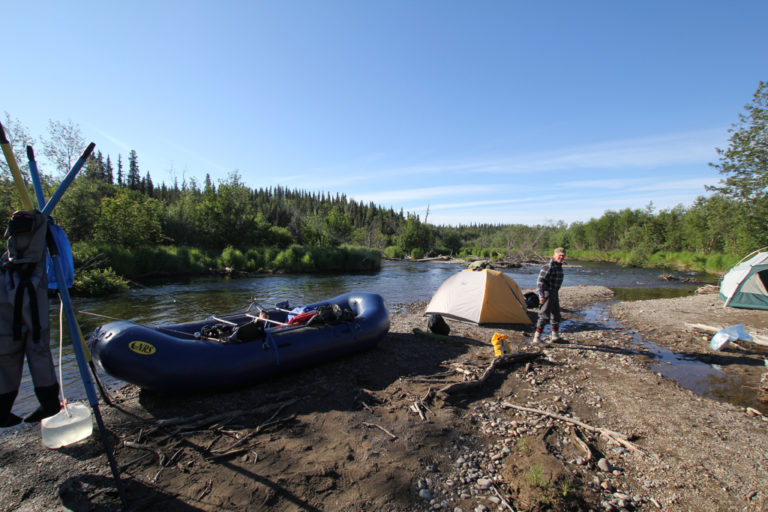
The river opens up as it approaches the lake; the terrain is marshy, the river now 200 feet wide with a surface like glass. Robby dabbles again with a parachute Adams, and lands the biggest rainbow of the trip, a 25 Incher.

One might be surprised that 25 inches is the measure of our biggest rainbow, but keep in mind that we deliberately scheduled our trip to avoid the salmon run. The benefit is that we got to use all fly fishing techniques – using dries, streamers, terrestrials and nymphs. Once the salmon are in, the rainbows grow much larger as they gorge on eggs and salmon flesh – but the fly fishing then is pretty well restricted to one type of presentation – nymphing with egg patterns and flesh flies.

Now its time for the plane to pick us up and fly us back to civilization. The trip of a lifetime!

We arranged our trip through Rainbow River Lodge, which is owned and operated by Chad Hewitt. I now have a lot of appreciation for the outfitter of such a trip who must provide, bush plane, food, raft, tents and equipment, and of-course a great guide and oarsman – our guy Jon Streeter.
Words By John Hogg Photos By Robby Hogg
Fly Fishing at Sierra College: Learn to Fly Fish with John Hogg
John Hogg is the new Fly Fishing instructor at Sierra College. He runs two classes a year. His spring class is coming up on April 5, 2014. Click on the link below to sign up for the class. This two-day class provides an introduction to the art of fly fishing. Topics include equipment, knot tying, stream habitat, aquatic entomology, tips and techniques. Fly casting equipment will be available for student use, but bring your own if you have it. The Saturday session will have a one-hour lunch break with a fly-casting clinic to follow. Sunday session is a day-long fly fishing trip to Big M Fishery —you provide your own transportation. Materials: $15 at class includes a starter pack of flies; students will also pay a $15 entry fee to Big M Fishery.
